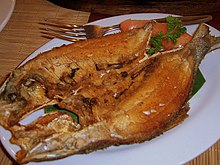 | |
| Alternative names | Bilad, Tuyô, Pinikas, Buwad |
|---|---|
| Place of origin | Philippines |
| Variations | Labtingaw, lamayo |
Daing, tuyô, buwad, or bilad (lit. 'sun-dried' or 'sun-baked') are dried fish from the Philippines.[1] Fish prepared as daing are usually split open (though they may be left whole), gutted, salted liberally, and then sun and air-dried. There are also "boneless" versions which fillet the fish before the drying process.[2] It was originally a preservation technique, as salt inhibits the growth of bacteria, allowing fish to be stored for long periods of time.[3][4]
Daing is fried or grilled before consumption, though it can also be wrapped in foil and baked in an oven. It is usually dipped in vinegar and eaten with white rice for breakfast.[5] Notably, it is traditionally paired with champorado (traditional Filipino chocolate rice gruel).[6] It can also be used as an ingredient in other dishes.[7]
Daing is considered poverty food because it's relatively cheap but has gained significance in Philippine culture as comfort food.[2][8]
- ^ "Philippine Dried Fish". CloveGarden. Retrieved November 1, 2014.
- ^ a b Cite error: The named reference
mm1was invoked but never defined (see the help page). - ^ "How to Make Salted Dried Fish (Daing)". Pinoybisnes.com. November 15, 2009. Retrieved November 1, 2014.
- ^ "How to Start a Salted Dried Split Fish (Daing) Business". Business Diary. September 21, 2011. Retrieved November 1, 2014.
- ^ "How to Cook Dried Herring (Tunsoy - Tuyo Fish)". Today's Delight. March 31, 2018. Retrieved May 7, 2021.
- ^ "Champorado with Tuyo – Chocolate Porridge with Salted Dried Fish". Panlasang Pinoy. December 9, 2016. Retrieved May 7, 2021.
- ^ Laureta, Isabelle (February 18, 2015). "19 Surprisingly Delicious Meals You Can Make With Tuyo". BuzzFeed. Retrieved May 7, 2021.
- ^ Cite error: The named reference
danggitwas invoked but never defined (see the help page).